If you’re on a quest to decipher the Net Promoter Score® calculation (and the math behind it), look no further.
What is the NPS formula? (+ how to Calculate NPS)
The standard NPS formula subtracts the percentage of detractors from the percentage of promoters. So, to calculate NPS, first ask your customer base the standard NPS question: “How likely are you to recommend us on a scale from 0 to 10?” If 80% of respondents are promoters and 10% are detractors, then you have an NPS of 70.

The NPS formula
The formula only makes sense if you know what the promoter and detractor labels truly mean—and how they get assigned in the first place.
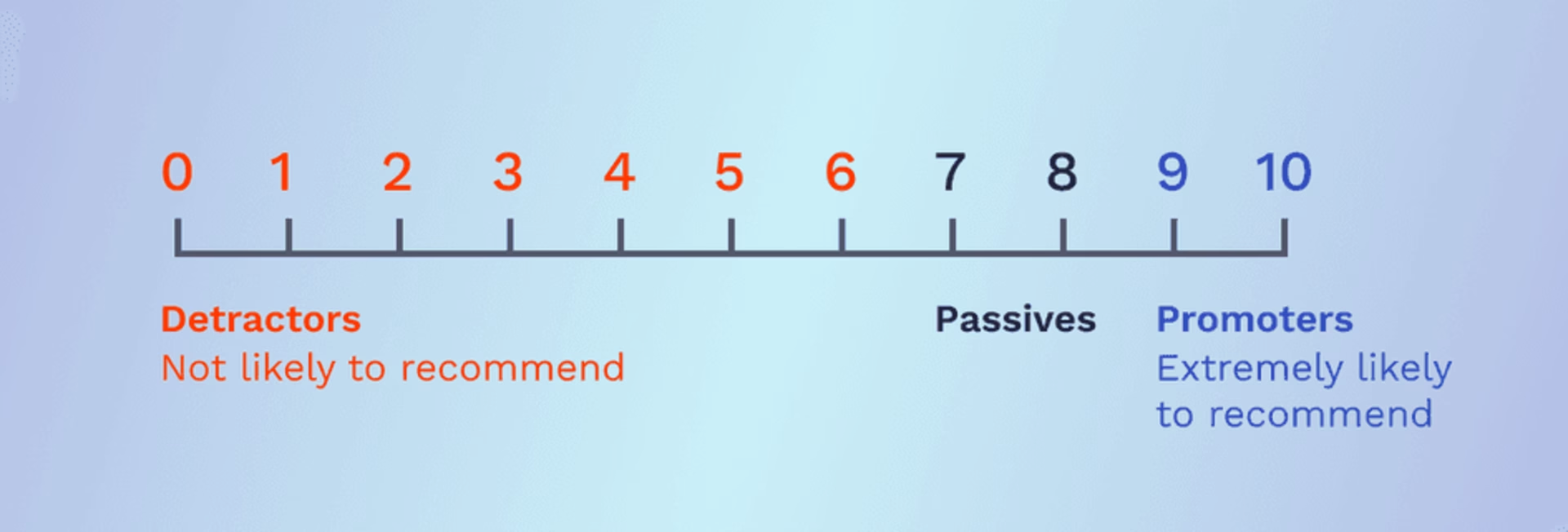
What is a promoter in NPS?
A promoter is anybody who answers the question "How likely are you to recommend this product/service/company to a friend or colleague?" with a score of 9 or 10.
As your most enthusiastic and loyal customers, promoters are likely to act as your brand ambassadors and rack up word-of-mouth referrals, which in turn helps fuel growth.
What is a detractor in NPS?
A detractor is anybody who answers the question "How likely are you to recommend this product/service/company to a friend or colleague?" with a score between 0 and 6 (included).
They’re obviously not your biggest fans. But it’s worse than that: not only are they not likely to recommend you to others—they’re the first candidates for leaving you, and they might even actively discourage other people away from you. One of your main goals is to make sure you have fewer detractors than promoters.
What about passives?
Sat in the middle of detractors and promoters are the passives, who answered the NPS question with a score of 7 or 8. Technically, you should look at them as old or new customers who are ‘passively satisfied’ with your product or service but are not supremely loyal to it, which means they can be snatched away by the competition.
💡 Pro tip: passives are not directly included in the NPS calculation, but don’t underestimate their importance. They’re so close to being promoters, especially when they give you a score of 8, that any time spent investigating what you could do to win them over is time well spent. Consider it an opportunity to collect and analyze their customer feedback.
2 NPS calculation methods
We’re going to take you through three main methods for calculating your NPS, using:
A spreadsheet/Excel
A survey tool with an NPS feature
We’re also adding a bonus method that shows you the math behind the NPS formula so you can calculate it with pen and paper…should you ever want to!
Here’s an example of a simple two-column chart with NPS survey data:
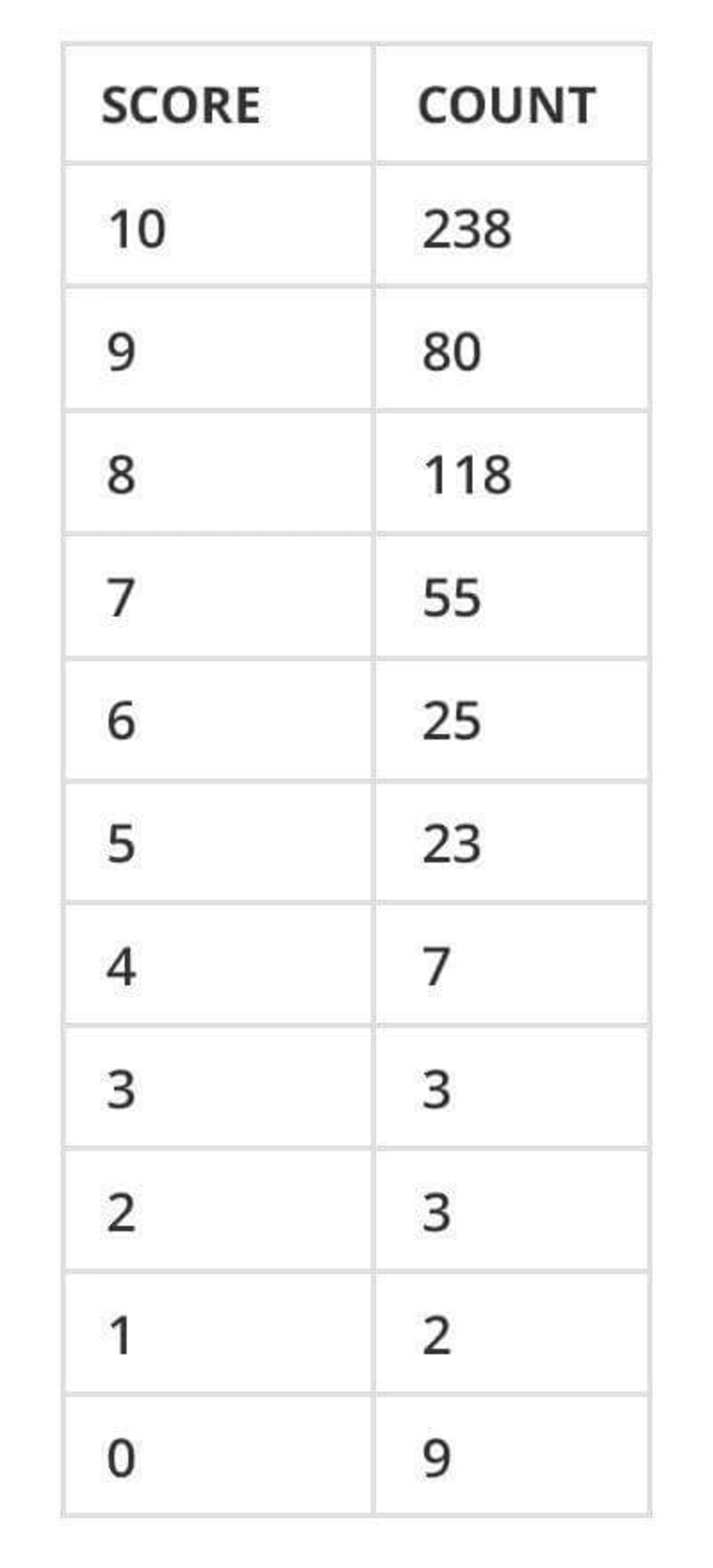
1. How to calculate your NPS in Excel/Google Sheets
The Excel or Google Sheets spreadsheet method is best when your raw NPS data is just rows of numbers between 0 and 10 that need to be categorized as promoters, detractors, and passives:
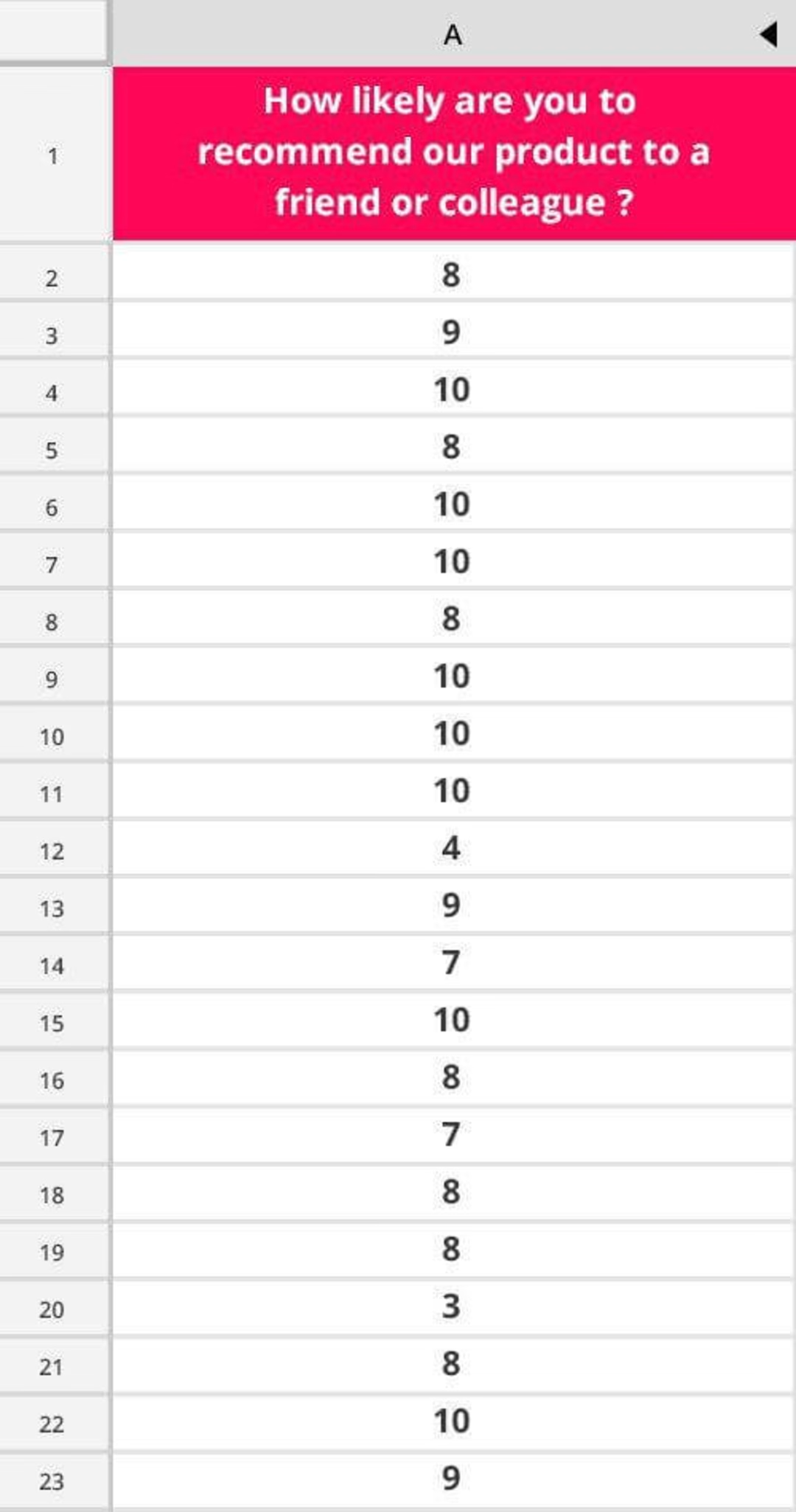
An example of uncategorized NPS results
How to calculate NPS in Excel:
Add up the promoters—those who scored 9 and 10
Add up the detractors—those who scored 0 through 6
Divide the number of promoters by the total number of responses to calculate the percentage
Repeat this process for detractors
Apply the NPS formula: percentage of promoters minus percentage of detractors
Excel template for calculating NPS
To expedite the process, we created a spreadsheet template with the NPS formula ready to go. Here’s how to use it:
Make a copy of the spreadsheet template or download it as an .XLS file
Export the data from your NPS survey results into a .CSV or .XLS file
Copy the data from your results file and paste it into the template sheet named ‘NPS calculation’, in the cell marked with :
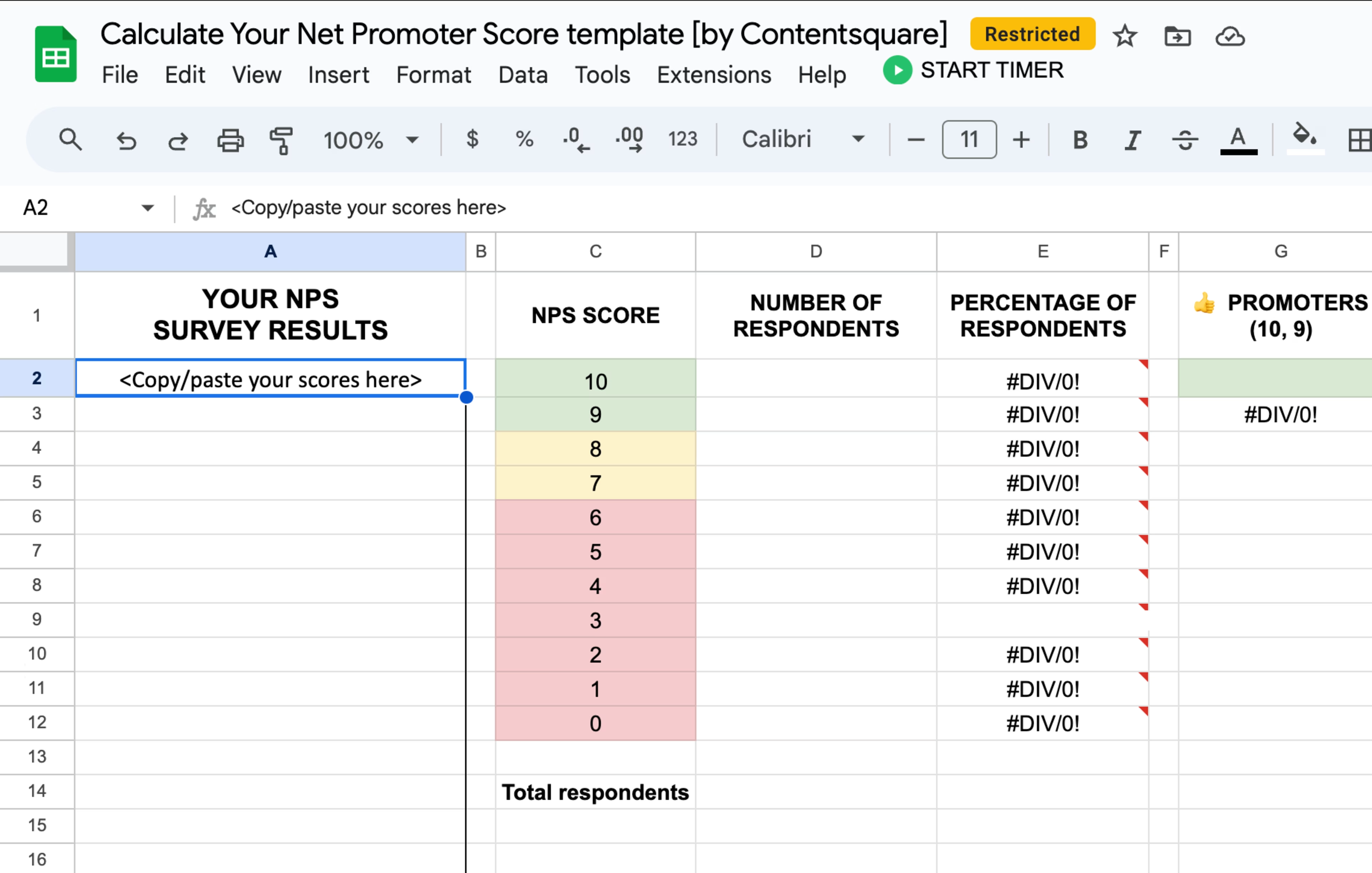
After you paste your scores, the formula in the spreadsheet will automatically
Display the count for each score from 10 to 0
Count your total number of respondents, promoters, detractors, and passives
Calculate and display your NPS
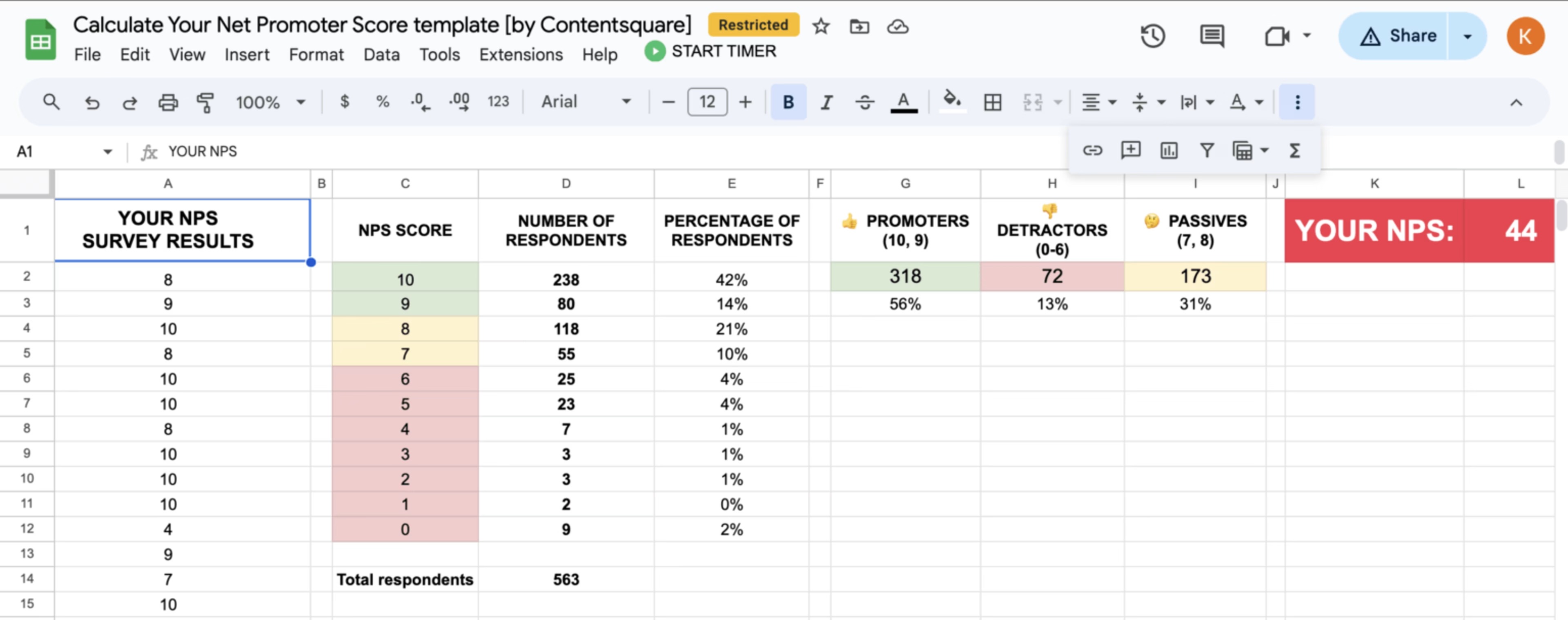
We also added a sheet called ‘NPS calculation - example dataset’ to the template so you can see how it works. Try to change a few numbers here and there and see how that affects the NPS. As you make sense of the numbers, you might wonder what a good Net Promoter Score® looks like. Well, it actually varies vastly across industries, but a score of 60 or higher is generally a very good NPS.
2. How to calculate your NPS with a survey tool
Before calculating your NPS score, you’ll first need to pose the NPS question to your customers using a survey tool. If you collect your NPS data with an online survey tool, the good news is that it might already have an auto-calculate function built in that lets you get your NPS in one click.
The NPS software that powers Contentsquare surveys, for example, automates the Net Promoter Score® calculation and lets you easily track your score. We even have a pre-built NPS survey template that you can set up in seconds and strategically place on your website to pose the NPS question at crucial touchpoints along the customer journey.

Track your NPS
If you want to know how to improve your NPS, you need to track how it changes over time. Thankfully, NPS survey tools like Contentsquare cut out the time it would take you to continually calculate your NPS by hand.
Contentsquare’s NPS dashboard widget enables you to track real-time changes to your score, so you can keep tabs on it daily or visualize trends over longer periods.
👉Read our chapter on how to track NPS for more detail!
Two main benefits of using a survey tool like Contentsquare to calculate your NPS:
You don’t have to do any data exporting or copy-pasting, which saves time and removes the potential for errors
The spreadsheet gives you a snapshot of your current situation; an NPS survey tool also helps you track changes, trace daily NPS fluctuations for the previous 30 days, and monitor weekly/monthly fluctuations for the past 12 months.
💡 Pro tip: to make the most of your Contentsquare NPS survey, follow up the NPS scale with an open-ended question—ask your detractors what would improve their score and your promoters what would wow them. Check out our survey question bank for further follow-up question ideas, or try running a tandem customer satisfaction (CSAT) survey to dive right into the customer experience.
And with Contentsquare’s Voice of the Customer AI, there’s no need to worry about high survey response rates that leave you sifting through every single answer overwhelmed. Our AI will prepare an automated summary report of your survey results that includes key insights, survey respondent quotes, and actionable next steps.
Bonus method: the math behind the NPS calculation
If you’re interested in how the NPS formula works—or if you ever find yourself wanting to calculate it with just pen and paper—here’s the math behind it:
Count the promoters by adding up the number of 9 and 10 responses (using the same dataset as the examples above, we have 238 + 80 = 318 promoters)
Repeat the same process for detractors by adding up the number of responses from and including 0 to 6 (in our case, that’s 9 + 2 + 3 + 3 +7 +23 + 25 = 72 detractors)
Calculate the percentage of promoters by dividing the number of promoters by the total number of responses (our dataset brings us to 318/563 = 0.56, or 56% when expressed as a percentage)
Repeat the same process for detractors by dividing the number of detractors by the total number of responses (for us, that’s 72/563 = 0.12 or 12%)
Finally, apply the NPS formula: percentage of promoters minus percentage of detractors (in our case: 56 - 12 = 44). And that’s how you calculate your NPS manually.
Net Promoter, Net Promoter System, Net Promoter Score, NPS and the NPS-related emoticons are registered trademarks of Bain & Company, Inc., Fred Reichheld and Satmetrix Systems, Inc.

![[Visual] Contentsquare's Content Team](http://images.ctfassets.net/gwbpo1m641r7/3IVEUbRzFIoC9mf5EJ2qHY/f25ccd2131dfd63f5c63b5b92cc4ba20/Copy_of_Copy_of_BLOG-icp-8117438.jpeg?w=1920&q=100&fit=fill&fm=avif)